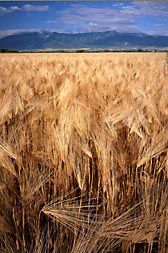A New Approach to Molecular Plant Breeding
|
|
An ARS scientist in Ithaca, New York, is using a new statistical approach to help speed the development of improved varieties of crops.
Plant breeders constantly strive to breed new varieties that yield more, resist emerging pests and pathogens, tolerate heat and drought, and grow in marginal soils and environments. Increasingly, molecular tools are used to speed those efforts. By identifying genes associated with desirable traits, scientists don’t have to wait for time-consuming field observations.
“To grow wheat and evaluate it for traits in the field takes 5 to 9 years. Using genomic data, we can do it in about 6 months,” says Jean-Luc Jannink, who is in the ARS Plant, Soil, and Nutrition Research Unit at the Robert W. Holley Center for Agriculture and Health on the Cornell University campus, in Ithaca.
Though molecular tools speed up the process, they also require analyzing massive amounts of data. Jannink has demonstrated how new statistical approaches should help plant breeders handle all that data. Analysis of the data enables “genomic selection” (GS) of untested breeding lines, using predictions about which will perform best. Dairy cattle breeders have begun to use GS, and with Jannink’s help, it will catch on among plant breeders.
Even with modern molecular tools, breeders face challenging traits like drought tolerance and high yield, which result from the combined action of multiple genes, each having a small effect. These genes, called “quantitative trait loci” (QTLs), are stretches of DNA that affect an observable trait. The conventional marker-assisted selection (MAS) approach has limited power when a trait is affected by small-effect genes. The sheer volume of data involved forces MAS to exclude some small-effect QTLs when individual plants are selected for further breeding.
|
|
Jannink’s approach exploits more genetic data by including all of the small-effect QTLs and estimating the effects of all of the known genetic markers in a plant population. In a recent study, Jannink and his colleagues constructed statistical models, using both GS and MAS approaches, and compared how well they could predict the values of 13 agronomic traits in crosses made from a “training population” assembled for the study. The accuracy of the models was measured by comparing their predictions with field observations of 374 lines of wheat, characterized by Mark Sorrells, a collaborator and wheat breeder at Cornell University. In their study, Jannink and colleagues were able to use all the available data, including all of the trait data, along with the genomewide marker data that captured the genetic values of the wheat lines.
The results, published in the March 2011 issue of The Plant Genome, showed that the GS approach was more accurate at predicting trait values than the MAS method was. Jannink reported similar success in another study, this time of oats, published in June 2011 in The Plant Genome. The work is expected to speed up molecular breeding efforts and might prove extremely useful, given the rapid pace of advances in DNA technology, Jannink says.—By Dennis O'Brien, Agricultural Research Service Information Staff.
This research is part of Plant Genetic Resources, Genomics, and Genetic Improvement, an ARS national program (#301) described at www.nps.ars.usda.gov.
Jean-Luc Jannink is with the USDA-ARS Robert W. Holley Center for Agriculture and Health, 538 Tower Road, Cornell University, Ithaca, NY 14853; (607) 255-5266.
"A New Approach to Molecular Plant Breeding" was published in the April 2012 issue of Agricultural Research magazine.








